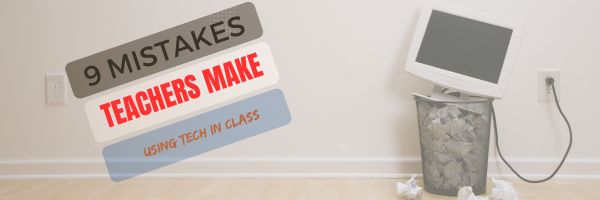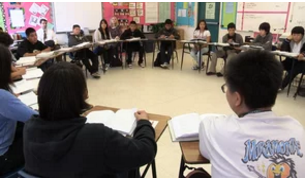It’s easy to confuse ‘using technology’ with digital tools. Your school passed iPads out to all classes. Some of your colleagues think having students read in this tablet format means they’re integrating technology into their curriculum. Kudos for a good start, but they need to use the tablets to differentiate for student learning styles, enrich learning materials, and turn students into life-long learners.
That’s harder than it sounds. Technology hasn’t been around long enough to beget standards that work for everyone (not withstanding ISTE’s herculean efforts), the set-in-stone of settled science. Truth, that will never happen. Technology tools populate like bacteria in a culture. Every time you turn around, there’s another favorite tool some teacher swears has turned her students into geniuses and her class into a model of efficiency. After fifteen years of teaching technology, chatting with colleagues, and experimenting, I can assure you there is no magic wand. What there is is a teacher not afraid to try new ways, test them out in a classroom environment, toss what doesn’t work and share the rest. Her/his success doesn’t come without lots of failure and mistakes, widgets that sounded good but were too complicated or non-intuitive for a 21st century classroom.
Which of these nine mistakes do you make? Then, see how to fix them:
- Only use iPads in place of books or game-play? They’re so much more than that. Next time, use them to teach digital tools, how-to lessons (i.e., how to search for the app the student wants to use), research, communicate, and/or draw an inquiry-themed picture.
- Still passing out paper newsletters and announcements to parents? Launch a paper-free approach on Earth Day (April 22nd). Get rid of those piles of paper parents use as a crutch. Create newsletters in Google Docs, Word, or Canva, save as a pdf if necessary and email or simply share. Embed the newsletter into your class blog. Share the link to an online newsletter through your class Twitter stream.
- Sending kids to the computer lab to do work rather than using the class computer or the library computers? I know–this sounds crazy. I’m including it because teachers in my school do this! When I ask about it, the usual answer is that something about the classroom computer doesn’t work as well as the lab. That’s an opportunity for me to fix their problem, show students how to fix it, extend my reach.
- Not trying to solve tech problems before calling for help? You’re using technology on a class project. Something goes wrong, and you throw your hands up–can’t continue until someone from tech–or a student–fixes the problem. Next time, logically think through how to solve the problem. Sometimes, it’s as simple as ‘Plug in the device” or “Reboot”. Other times, it’s more complicated. Doesn’t matter. This is an opportunity to model problem solving for students. Show them the thought process you engage to solve problems. Show them you aren’t afraid, nor intimidated. You see it as an opportunity.
- Think kids know more about tech than you do? Some do, but most don’t, and what they don’t know is how to learn and/or teach it. You do. Even if you stay only one step ahead, you will learn faster and more efficiently because you are a mature life-long learner. It’s fine to use student knowledge, but recognize the limitations.
- Not using technology every time possible? For example, to time a test. Pull out your smartphone and open the ‘clock’ app which usually includes a timer and a stop watch. Take pictures with iPads. Look up tricky words in situ–while students are stumbling over them–using an online dictionary. Have a running ‘question’ section on the Smartscreen–generated by whatever backchannel device you use (a class Twitter account works nicely) to show students what classmates are thinking as you lecture. Encourage students to do the same.
- Asking students to unplug at the classroom door? They don’t want to. It makes them consider the learning less relevant. Why do this? Flip it–ask them to plug in. If they could, how would they use technology to further their learning? See what they say.
- Afraid to make mistakes in front of students? Don’t be! Let them understand mistakes are not traumatic, rather part of life. Everyone makes them, from students to teachers to geniuses like Albert Einstein and Stephen Jobs. What’s relevant is that the student recognize the mistake and seek out a solution. Discuss this, then expect them to do so when they have a problem. Approach everything that goes on in your classroom as a ‘teachable moment’ (boy, I hate that phrase). A learning experience.
- Forgetting to let kids make choices? You have a lesson plan. A student offers a better way. What’s wrong with that? Every lesson plan should start with a conversation. Use it to determine KWL–what students know, want to know, and learned. Add a piece called ‘planning’. Include students in this. Share the tech required for your plan and get their take on it. There may be some who have difficulty understanding the relevance of the technology you selected. Maybe it focuses on writing and they’re artists. Address that. Are their concerns authentic or fear of the unknown? See if they have a better plan that achieves the same goals as you have set out. This doesn’t take as long as you think it will, and the time expended is well made up in the enthusiasm students now approach their scholastic work.
Those are my nine. They started my teaching career and I have made every effort to overcome them. It doesn’t always work, but it’s my guideline. I’m not afraid to tell you about them, nor that I don’t always succeed in solving them. What mistakes do you make as you attempt to use tech in the classroom? Maybe I can help.
–image credit Deposit Photo
Jacqui Murray has been teaching K-18 technology for 30 years. She is the editor/author of over a hundred tech ed resources including a K-12 technology curriculum, K-8 keyboard curriculum, K-8 Digital Citizenship curriculum. She is an adjunct professor in tech ed, Master Teacher, webmaster for four blogs, an Amazon Vine Voice, CSTA presentation reviewer, freelance journalist on tech ed topics, and author of the tech thrillers, To Hunt a Sub and Twenty-four Days. You can find her resources at Structured Learning.






































I have seen some of those mistakes, but not all. One of the biggest I saw was simply fear – fear of using technology.
That might be the biggest, Norah. I’ve seen technophobia freeze teachers from even making an effort.
Yes, that fear can be immobilising. I guess in the ‘old’ mechancial days, we were afraid of breaking something if we twisted it the wrong way.